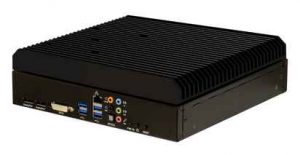Small form factor solutions such as COM Express (Computer On Module) are becoming ever more popular, able to solve problems that used to be approached using modular 19” technology based systems. The increase in performance level of newer chips and the integration of many functions into off the shelf single board solutions give designers a host of possibilities when approaching a new design. Many designers find themselves choosing between a modular building block approach that may fit their application imperfectly versus a custom mainboard development that may be expensive and time-consuming to bring to market. Particularly in situations where the application demands low to medium volume deployment, a modular, single board computer based approach has strong advantages. Here are five considerations when selecting a modular single board based solution:
What is the application volume?
For low and medium volume deployments, the cost to develop and manufacture a custom mainboard based solution can be a showstopper. Taking advantage of a versatile off the shelf modular solution, such as this one based on COM Express, can solve this problem for deployments as low as 50 pieces or less. A similar modular solution can use a modified carrier board tailored to the application and still deploy in volumes of 100 – 1,000 pieces depending on the complexity. Custom mainboards can require volume in the thousands of pieces to be economically viable.
Which COM to select?
There are many types of COMs available on the market as off the shelf components. Application demands can dictate what features and types are chosen. Using off the shelf COMs is advantageous in both cost and development time. Some COM types include COM Express, QSeven and SMARC.
Which Carrier Board to select?
The carrier board will house the COM and provide all necessary user I/O for the application. Power is also provided to the COM via the carrier. Many off the shelf carrier boards exist for specific modules and applications. Some carrier boards are set up for general use with many I/O and expansion options such as the one shown in this video. Combining a general use carrier board with a user selected COM can lead to a custom application specific computer that is available quickly and in low to medium volume.
The Power Solution
Different carrier board and COM combinations will have different power requirements based on the I/O types and particularly on the COM processor power. Application and regional deployments may also define unique power needs. Selecting a carrier that has a modular power unit can save the need to develop a custom power solution integrated into the carrier, and may leave the solution flexible to different power needs for different deployments.
Cooling Solution & Enclosure
Processing power on the COM and environment at the deployment site are the two largest factors in determining system cooling needs. Applications in industrial, transportation or rugged applications may need heatsinks and a rugged, sealed enclosure to protect the electronics inside. Lab or indoor use equipment may take advantage of fans to provide forced air cooling. EMI shielding requirements are another consideration for the enclosure. Selecting a modular enclosure that supports these options and is compatible with a general use carrier board can be the building block for a versatile integrated system that solves all application needs.
Learn about selecting a COM based modular integrated system: download free whitepaper here!



